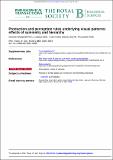Files in this item
Production and perception rules underlying visual patterns : effects of symmetry and hierarchy
Item metadata
| dc.contributor.author | Westphal, Gesche | |
| dc.contributor.author | Huber, Ludwig | |
| dc.contributor.author | Gomez, Juan-Carlos | |
| dc.contributor.author | Fitch, William Tecumseh Sherman | |
| dc.date.accessioned | 2012-07-13T12:31:01Z | |
| dc.date.available | 2012-07-13T12:31:01Z | |
| dc.date.issued | 2012-07-19 | |
| dc.identifier | 22357359 | |
| dc.identifier | 716f66d4-0cc6-47ff-90dd-6abfadd774b2 | |
| dc.identifier | 84862121798 | |
| dc.identifier | 000305293500007 | |
| dc.identifier.citation | Westphal , G , Huber , L , Gomez , J-C & Fitch , W T S 2012 , ' Production and perception rules underlying visual patterns : effects of symmetry and hierarchy ' , Philosophical Transactions of the Royal Society. B, Biological Sciences , vol. 367 , no. 1598 , pp. 2007-2022 . https://doi.org/10.1098/rstb.2012.0098 | en |
| dc.identifier.issn | 0962-8436 | |
| dc.identifier.other | ORCID: /0000-0002-0218-9834/work/64361101 | |
| dc.identifier.uri | https://hdl.handle.net/10023/2983 | |
| dc.description.abstract | Formal language theory has been extended to two-dimensional patterns, but little is known about two-dimensional pattern perception. We first examined spontaneous two-dimensional visual pattern production by humans, gathered using a novel touch screen approach. Both spontaneous creative production and subsequent aesthetic ratings show that humans prefer ordered, symmetrical patterns over random patterns. We then further explored pattern-parsing abilities in different human groups, and compared them with pigeons. We generated visual plane patterns based on rules varying in complexity. All human groups tested, including children and individuals diagnosed with autism spectrum disorder (ASD), were able to detect violations of all production rules tested. Our ASD participants detected pattern violations with the same speed and accuracy as matched controls. Children's ability to detect violations of a relatively complex rotational rule correlated with age, whereas their ability to detect violations of a simple translational rule did not. By contrast, even with extensive training, pigeons were unable to detect orientation-based structural violations, suggesting that, unlike humans, they did not learn the underlying structural rules. Visual two-dimensional patterns offer a promising new formally-grounded way to investigate pattern production and perception in general, widely applicable across species and age groups. | |
| dc.format.extent | 16 | |
| dc.format.extent | 1755851 | |
| dc.language.iso | eng | |
| dc.relation.ispartof | Philosophical Transactions of the Royal Society. B, Biological Sciences | en |
| dc.subject | BF Psychology | en |
| dc.subject | QH301 Biology | en |
| dc.subject.lcc | BF | en |
| dc.subject.lcc | QH301 | en |
| dc.title | Production and perception rules underlying visual patterns : effects of symmetry and hierarchy | en |
| dc.type | Journal article | en |
| dc.contributor.institution | University of St Andrews. School of Psychology and Neuroscience | en |
| dc.contributor.institution | University of St Andrews. Institute of Behavioural and Neural Sciences | en |
| dc.contributor.institution | University of St Andrews. Centre for Social Learning & Cognitive Evolution | en |
| dc.identifier.doi | 10.1098/rstb.2012.0098 | |
| dc.description.status | Peer reviewed | en |
This item appears in the following Collection(s)
Items in the St Andrews Research Repository are protected by copyright, with all rights reserved, unless otherwise indicated.

